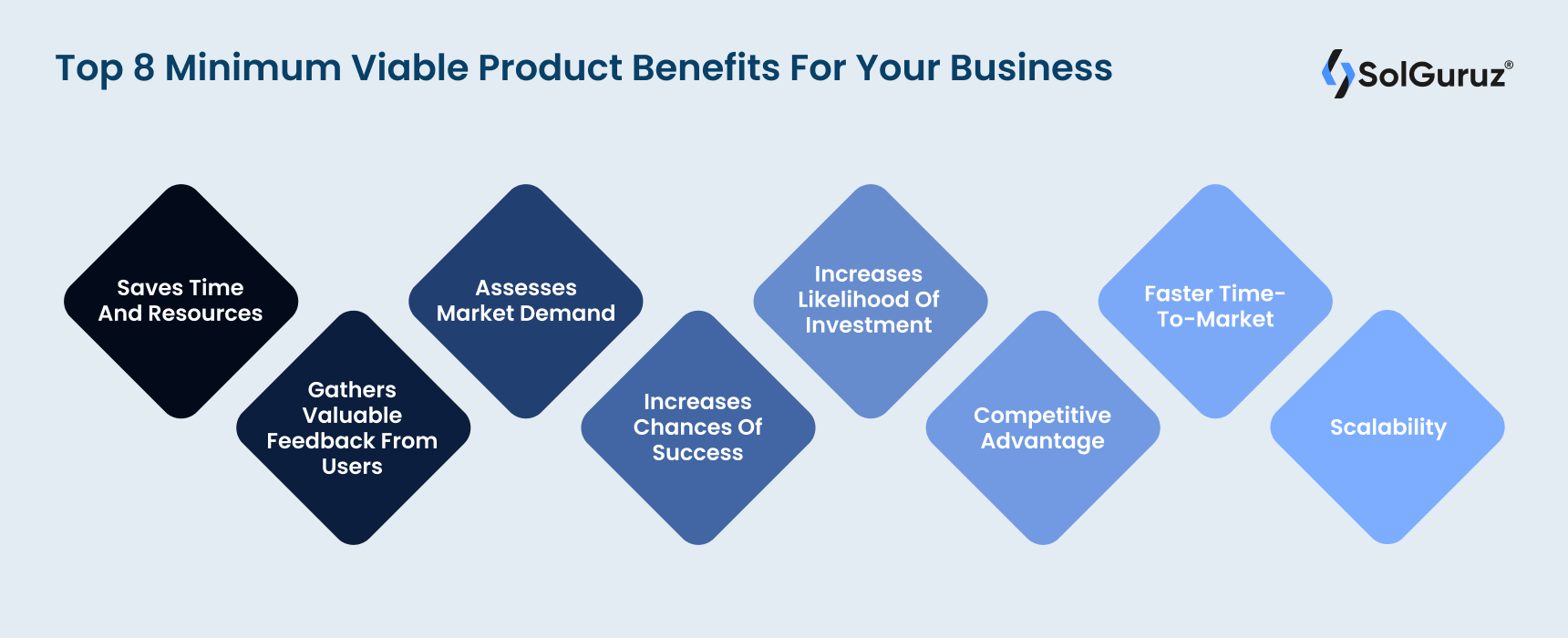Engineering Quality Solutions
Maximize success, minimize risk with Minimum Viable Product aka MVP development. Learn 8 key benefits of MVP Development for your idea.
By Lokesh Dudhat
Last updated on: November 11, 2024

A minimum viable product, in its simplest form, allows you to validate your business idea as quickly and cheaply as possible. In today’s startup-friendly ecosystem, the concept of a minimum viable product is becoming increasingly popular and the benefits of MVP Development show its immense potential.
The idea is to release a fully operational product with ample scope for improvement. This allows the company to provide real value (and make money) while it continues working on refining its product.
If you’re thinking about building (or have already launched) a startup but need to know if an MVP is right for your business, consider these eight compelling benefits of MVP Development.

One significant benefit of building an MVP is that it saves time and resources. By only building around a product’s essential features, businesses can test and validate their product idea without investing significant time and resources.

This method enables you to swiftly and efficiently collect feedback from potential users. You can make necessary adjustments before fully committing to developing a complete product.
Additionally, by testing an MVP, businesses can avoid the costs of developing and launching a full product that may fail to be successful.
By validating their product idea early on, they can identify potential issues and make changes before investing a lot of resources. This can aid them in avoiding expensive errors and enhance their chances of success in the long term.
MVP development allows you to gather valuable user feedback. By releasing a minimal product version to a small group of users, you can gather feedback on the product’s usability, design, and overall value. You can use this data to refine the product before it is fully released.
Gathering feedback from users early on can also help you identify and address any issues or problems with the product before it goes to market. This allows you to make necessary adjustments and improve the overall user experience, leading to higher customer satisfaction and a higher likelihood of success for the product.
Additionally, by incorporating user feedback, you can increase the chances of product-market fit and ensure their product addresses the real problems and needs of the users.
The goal of an MVP is to learn if there is a market for your product.
You should build an MVP when you don’t know if there will be a market for your product and want to test it before committing resources to build a full-featured solution. Your MVP serves as a great proof-of-concept for users and investors alike.

A proof of concept (POC) demonstrates the feasibility of a proposed concept or solution. A POC is typically used to validate that a system, application, or component will work as expected and meet all requirements.
An MVP helps you learn if your idea has potential and gives you data on how people use it, so you can make informed decisions about whether or not to continue developing it. Here’s how:
Creating an MVP allows companies to test their ideas in the market and make necessary adjustments before investing heavily into the final product. This increases the chances of success by identifying and addressing potential issues early on and making necessary adjustments before it’s too late.

MVPs are not about creating something average that’s good enough for now and will be replaced by something better in the future. They are about creating something great that can be improved later but still serves a purpose.
An instance of a company that has effectively applied an MVP approach is Airbnb. In the early days, the founders of Airbnb created a website that allowed users to list and book rooms. They then tested this MVP by offering free stays to friends and family and gathering feedback. Based on the feedback, they made adjustments and improvements to the site and continued testing and iterating until they had a fully-functional app they launched in 2012. Currently, Airbnb is a company valued at over 64 billion dollars, with over 5.6 million listings worldwide.
Another example is the social media platform Twitter. Twitter’s MVP was a simple text messaging service that allowed users to send and receive short, 140-character messages. This MVP enabled them to experiment with the idea and collect feedback from early users. Based on the feedback, they made adjustments and improvements to the site and continued to test and iterate until they had a fully-functional product that could be scaled up. Currently, Twitter is one of the most widely used social media platforms, boasting over 450 million monthly active users.
Creating an MVP also increases the likelihood of investment from potential investors or venture capitalists. An MVP demonstrates to investors that a company has a clear idea of what they want to achieve and how they plan to achieve it.
It also shows that the company has done its research and has a solid understanding of its target market and growth potential. This makes the company more attractive to potential investors, who are more likely to invest in a company with a clear plan and a proven track record of success.
For example, Dropbox was able to secure funding from investors after creating an MVP that demonstrated the potential for its cloud storage service. The MVP was a simple video that showed how the service would work and how it would solve a problem for users. They released the video on Hacker News in April 2007. This 30-second video generated interest from investors and helped secure funding for the company to develop its final product. Today, Dropbox is a billion-dollar company with over 700 million registered users.
A recent report by CBinsights indicates that 38% of startups fail due to a lack of funds. This emphasizes the significance of securing funding for startups as it can be the factor that determines success or failure. MVP development can help startups achieve their goal of securing funding and ultimately mitigate the risk of failure.
With the help of an MVP development company, you can gain a competitive advantage as they’ll test and validate your product or service before investing significant resources. This approach allows a company to gain a deeper understanding of customer needs, preferences, and pain points, which you can use to improve the product or service and make it more appealing.
MVP development allows a company to market its product or service quickly, which can be a significant advantage in highly competitive industries.
By being one of the first to market with a new product or service, a company can establish a strong brand presence and gain a foothold in the market before competitors can catch up.
One of the most important benefits of MVP development is that it allows a company to bring a product to market faster, eliminating the need to build out a full-featured product before testing its viability with users. This approach allows for a faster time-to-market and allows companies to learn from users early on, leading to a more successful product in the long run.
Faster time-to-market is a critical advantage in today’s fast-paced and competitive marketplace. By getting their product to market quickly, startups can gain valuable feedback from early adopters that can help them improve and iterate on their products.
The most important benefit of MVP development is scalability. If your product goes viral, you can always add more features and functionality. It’s much better than developing a full-fledged product only to discover that it isn’t what people want or need.
The MVP development approach allows the company to validate the product’s scalability potential. If the MVP proves successful, the company can invest more resources to expand the product’s features and capabilities to meet the growing demand.
As a business owner or startup founder, developing an MVP (Minimum Viable Product) is essential to validate your idea and test the market. However, the process of MVP development can be complex and time-consuming. This is where SolGuruz comes in to assist you for the MVP Development in 2023.
SolGuruz is a minimum viable product development company with proficient developers and designers that’ll collaborate closely with you to comprehend your needs and design a tailor-made MVP solution that fulfills your specific requirements. We employ the most latest technologies and industry standards to guarantee that your MVP is high-performing, scalable and user-friendly.
We can help you with all aspects of MVP development, including market research, prototyping, design, development, testing, and deployment. We’ll also offer continuous support and maintenance to ensure that your MVP is always current and operating efficiently.
In addition to traditional MVP development, we can help you validate your MVP idea, find early adopters, and gather feedback on what to improve. With SolGuruz, you can be confident that your MVP will be developed to the highest standards and will give you the best chance of success in the market.
Turning a product into an actual visual/tangible object refines your vision and makes it more real. It allows you to refine what you are constantly offering, and if you hit the right combination of features and pricing, your startup will be full speed ahead to success.
You should always build a minimum viable product before planning to raise your startup capital. There are plenty of benefits to doing so, including testing your idea on a limited scale and making improvements based on feedback.
Your MVP will definitely be different from what you want it to be, but it will at least help you gauge interest in your concept and figure out how to improve it before attempting to raise money.
Minimum Viable Product (MVP)’s main goal is to validate the fundamental assumptions of a business concept with minimal resources and in a short timeframe. Startups and entrepreneurs to test the market and gather feedback from early adopters. An MVP can also help attract investors or acquire early customers.
An MVP is successful when it achieves its intended purpose of validating core assumptions and gathering feedback from early adopters. It should have enough features to effectively demonstrate the value proposition and test the product’s core functionality while also being easy and inexpensive to build and maintain.
MVP is important in Agile development because it aligns with Agile’s core adaptive, iterative, and customer-centric principles. MVP allows teams to validate the core assumptions of a product early on in the development process before investing a significant amount of resources into building a full product.
When creating an MVP, there are some crucial features and advantages that should be considered. Above all, MVP should be capable of addressing the problem it aims to solve. Secondly, keep your MVP as simple as possible so that it is easy to use and understand.
When creating an MVP, it’s important to consider several key factors to ensure its success. Start by identifying the core value proposition and problem the product will solve, and understand the target market and their needs. Prioritize features and functionalities, keep the MVP simple and easy to build and maintain while considering the costs and resources required.
Written by
Lokesh is a Co-Founder and Chief Technology Officer at SolGuruz, a senior technical consultant with over 10 years of experience in exploring the horizon of the software development industry. He has worked closely with startups and enterprises, mentoring them in engineering their tech solutions. With a hands-on experience of 10+ years as a developer, he has delivered solutions using a wide range of technologies such as iOS, Android, Angular, Node, RTC, React, MongoDB, PostgreSQL, Python, and many more. At SolGuruz, we believe in delivering a combination of technology and management. Our commitment to quality engineering is unwavering, and we never want to waste your time or ours. So when you work with us, you can rest assured that we will deliver on our promises, no matter what.
Learn how launching an MVP can benefit your project by minimizing risks and focusing on core functionalities. SolGuruz can guide you through the MVP development process to ensure market validation.

Strict NDA

Flexible Engagement Models

1 Week Risk Free Trial
Give us a call now!

+1 (646) 703 7626
Sign up for our free newsletter

Don’t Just Dream Big - Let’s Make It Happen!
For over a decade, I’ve been at the forefront of turning bold, ambitious ideas into groundbreaking solutions. As the CEO of SolGuruz, I’ve had the privilege of helping startups and businesses not only tackle their biggest challenges but scale to new heights with products that don’t just compete - they dominate.
Every meeting with me isn’t just a conversation; it’s a launchpad for revolutionary ideas that can catapult into great products/services. Leaders who’ve taken the step to connect with me have walked away with actionable strategies that made their products unforgettable.
👉 Book a free strategy call with me now and experience the difference. This isn’t just advice - it’s the spark you need to ignite your next big breakthrough.
In a world full of ordinary, let’s create the AI-extraordinary.
Your moment is now - don’t let it pass by.
Paresh Mayani
CEO, SolGuruz
paresh@solguruz.us